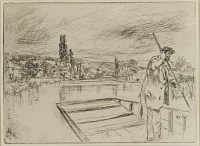The Punt | ||
| Number: | 82 | |
| Date: | 1861 | |
| Medium: | etching and drypoint | |
| Size: | 120 x 166 mm | |
| Signed: | 'Whistler' at lower left (1-3); 'W' partly removed (4-final) | |
| Inscribed: | '1861.' at lower left (1-3); partly removed (4-final) | |
| Set/Publication: | Junior Etching Club, 1862 | |
| No. of States: | 6 | |
| Known impressions: | 35 | |
| Catalogues: | K.85; M.86; T.85; W.68 | |
| Impressions taken from this plate (35) | ||
TECHNIQUE
It is mainly etching, with light, wavy drypoint lines added to suggest clouds, which wore down and were replaced as printing continued.
PRINTING
It is usually printed in black ink, sometimes on thin Japanese paper laid down on wove paper, but more often on wove paper. The majority of impressions in public collections are of platemark 120 x 165 mm on wove paper of 163 x 235 mm (i.e.  ,
,  ). There are examples of the large paper edition (
). There are examples of the large paper edition ( ) and impressions on Japanese paper laid down on wove paper (
) and impressions on Japanese paper laid down on wove paper (  and
and  ), and on wove paper (
), and on wove paper ( ).
).
 ,
,  ). There are examples of the large paper edition (
). There are examples of the large paper edition ( ) and impressions on Japanese paper laid down on wove paper (
) and impressions on Japanese paper laid down on wove paper (  and
and  ), and on wove paper (
), and on wove paper ( ).
).Some proofs were pulled by Frederick Goulding (1842-1909). These have not been identified. The Pennells record:
'For two of the plates of 1861, the Junior Etching Club found a place when, a year later, they published Passages from Modern English Poets, with their etchings as illustrations; and Whistler, occasionally trying his plates at the press of Day and Son, came into contact with the man, then a lad, he afterwards called "the best printer in England," Mr. Frederick Goulding, who sends us the following recollections of the time:
..."I mind me I first knew [Whistler] about 1859, when he used to come to the printing house where I was apprenticed (the old firm of Day and Son - in Gate Street, Lincoln's Inn Fields) and print himself at my father's press. I used some [t]imes to act as his 'devil' grinding the ink, and turning the press, and so on.
"I think the first plate I actually 'proved' for him was in 1861 - The Punt - he used to come frequently in the eighteen-seventies, and I then printed a good many plates for him.' 10
10: Pennell 1908, I, pp. 91-92, 96-97.
Whistler wrote on one impression,
After this a printer at Day & Son pulled another proof, on which Whistler, according to Kennedy, wrote 'Proof by Day's man.', and this impression, unfortunately not located, was acquired by Henry Harper Benedict (1844-1935). 11
11: Kennedy 1910 (cat. no. 85).
